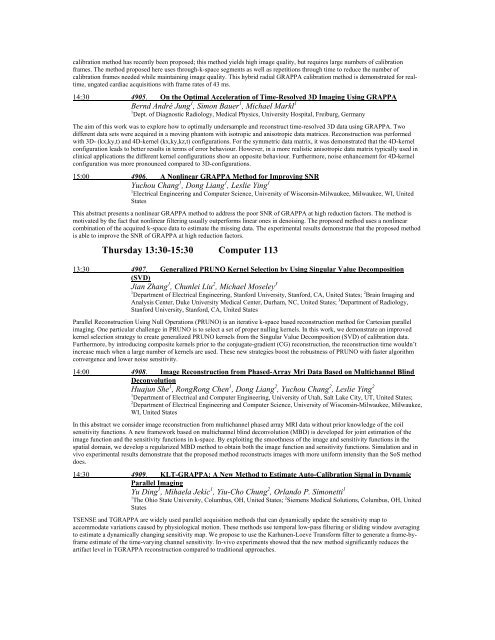ELECTRONIC POSTER - ismrm
ELECTRONIC POSTER - ismrm
ELECTRONIC POSTER - ismrm
You also want an ePaper? Increase the reach of your titles
YUMPU automatically turns print PDFs into web optimized ePapers that Google loves.
calibration method has recently been proposed; this method yields high image quality, but requires large numbers of calibration<br />
frames. The method proposed here uses through-k-space segments as well as repetitions through time to reduce the number of<br />
calibration frames needed while maintaining image quality. This hybrid radial GRAPPA calibration method is demonstrated for realtime,<br />
ungated cardiac acquisitions with frame rates of 43 ms.<br />
14:30 4905. On the Optimal Acceleration of Time-Resolved 3D Imaging Using GRAPPA<br />
Bernd André Jung 1 , Simon Bauer 1 , Michael Markl 1<br />
1 Dept. of Diagnostic Radiology, Medical Physics, University Hospital, Freiburg, Germany<br />
The aim of this work was to explore how to optimally undersample and reconstruct time-resolved 3D data using GRAPPA. Two<br />
different data sets were acquired in a moving phantom with isotropic and anisotropic data matrices. Reconstruction was performed<br />
with 3D- (kx,ky,t) and 4D-kernel (kx,ky,kz,t) configurations. For the symmetric data matrix, it was demonstrated that the 4D-kernel<br />
configuration leads to better results in terms of error behaviour. However, in a more realistic anisotropic data matrix typically used in<br />
clinical applications the different kernel configurations show an opposite behaviour. Furthermore, noise enhancement for 4D-kernel<br />
configuration was more pronounced compared to 3D-configurations.<br />
15:00 4906. A Nonlinear GRAPPA Method for Improving SNR<br />
Yuchou Chang 1 , Dong Liang 1 , Leslie Ying 1<br />
1 Electrical Engineering and Computer Science, University of Wisconsin-Milwaukee, Milwaukee, WI, United<br />
States<br />
This abstract presents a nonlinear GRAPPA method to address the poor SNR of GRAPPA at high reduction factors. The method is<br />
motivated by the fact that nonlinear filtering usually outperforms linear ones in denoising. The proposed method uses a nonlinear<br />
combination of the acquired k-space data to estimate the missing data. The experimental results demonstrate that the proposed method<br />
is able to improve the SNR of GRAPPA at high reduction factors.<br />
Thursday 13:30-15:30 Computer 113<br />
13:30 4907. Generalized PRUNO Kernel Selection by Using Singular Value Decomposition<br />
(SVD)<br />
Jian Zhang 1 , Chunlei Liu 2 , Michael Moseley 3<br />
1 Department of Electrical Engineering, Stanford University, Stanford, CA, United States; 2 Brain Imaging and<br />
Analysis Center, Duke University Medical Center, Durham, NC, United States; 3 Department of Radiology,<br />
Stanford University, Stanford, CA, United States<br />
Parallel Reconstruction Using Null Operations (PRUNO) is an iterative k-space based reconstruction method for Cartesian parallel<br />
imaging. One particular challenge in PRUNO is to select a set of proper nulling kernels. In this work, we demonstrate an improved<br />
kernel selection strategy to create generalized PRUNO kernels from the Singular Value Decomposition (SVD) of calibration data.<br />
Furthermore, by introducing composite kernels prior to the conjugate-gradient (CG) reconstruction, the reconstruction time wouldn’t<br />
increase much when a large number of kernels are used. These new strategies boost the robustness of PRUNO with faster algorithm<br />
convergence and lower noise sensitivity.<br />
14:00 4908. Image Reconstruction from Phased-Array Mri Data Based on Multichannel Blind<br />
Deconvolution<br />
Huajun She 1 , RongRong Chen 1 , Dong Liang 2 , Yuchou Chang 2 , Leslie Ying 2<br />
1 Department of Electrical and Computer Engineering, University of Utah, Salt Lake City, UT, United States;<br />
2 Department of Electrical Engineering and Computer Science, University of Wisconsin-Milwaukee, Milwaukee,<br />
WI, United States<br />
In this abstract we consider image reconstruction from multichannel phased array MRI data without prior knowledge of the coil<br />
sensitivity functions. A new framework based on multichannel blind deconvolution (MBD) is developed for joint estimation of the<br />
image function and the sensitivity functions in k-space. By exploiting the smoothness of the image and sensitivity functions in the<br />
spatial domain, we develop a regularized MBD method to obtain both the image function and sensitivity functions. Simulation and in<br />
vivo experimental results demonstrate that the proposed method reconstructs images with more uniform intensity than the SoS method<br />
does.<br />
14:30 4909. KLT-GRAPPA: A New Method to Estimate Auto-Calibration Signal in Dynamic<br />
Parallel Imaging<br />
Yu Ding 1 , Mihaela Jekic 1 , Yiu-Cho Chung 2 , Orlando P. Simonetti 1<br />
1 The Ohio State University, Columbus, OH, United States; 2 Siemens Medical Solutions, Columbus, OH, United<br />
States<br />
TSENSE and TGRAPPA are widely used parallel acquisition methods that can dynamically update the sensitivity map to<br />
accommodate variations caused by physiological motion. These methods use temporal low-pass filtering or sliding window averaging<br />
to estimate a dynamically changing sensitivity map. We propose to use the Karhunen-Loeve Transform filter to generate a frame-byframe<br />
estimate of the time-varying channel sensitivity. In-vivo experiments showed that the new method significantly reduces the<br />
artifact level in TGRAPPA reconstruction compared to traditional approaches.
















